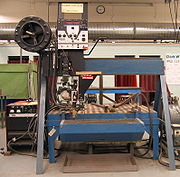
Submerged arc welding
Encyclopedia



Arc welding
Arc welding is a type of welding that uses a welding power supply to create an electric arc between an electrode and the base material to melt the metals at the welding point. They can use either direct or alternating current, and consumable or non-consumable electrodes...
process. Originally developed by the Linde - Union Carbide Company. It requires a continuously fed consumable solid or tubular (flux
Flux (metallurgy)
In metallurgy, a flux , is a chemical cleaning agent, flowing agent, or purifying agent. Fluxes may have more than one function at a time...
cored) electrode. The molten weld and the arc zone are protected from atmospheric contamination by being “submerged” under a blanket of granular fusible flux consisting of lime
Lime (mineral)
Lime is a general term for calcium-containing inorganic materials, in which carbonates, oxides and hydroxides predominate. Strictly speaking, lime is calcium oxide or calcium hydroxide. It is also the name for a single mineral of the CaO composition, occurring very rarely...
, silica
Silicon dioxide
The chemical compound silicon dioxide, also known as silica , is an oxide of silicon with the chemical formula '. It has been known for its hardness since antiquity...
, manganese oxide, calcium fluoride
Calcium fluoride
Calcium fluoride is the inorganic compound with the formula CaF2. This ionic compound of calcium and fluorine occurs naturally as the mineral fluorite . It is the source of most of the world's fluorine. This insoluble solid adopts a cubic structure wherein calcium is coordinated to eight fluoride...
, and other compounds. When molten, the flux becomes conductive, and provides a current path between the electrode and the work. This thick layer of flux completely covers the molten metal thus preventing spatter and sparks as well as suppressing the intense ultraviolet radiation and fumes that are a part of the shielded metal arc welding
Shielded metal arc welding
Shielded metal arc welding , also known as manual metal arc welding, flux shielded arc welding or informally as stick welding, is a manual arc welding process that uses a consumable electrode coated in flux to lay the weld...
(SMAW) process.
SAW is normally operated in the automatic or mechanized mode, however, semi-automatic (hand-held) SAW guns with pressurized or gravity flux feed delivery are available. The process is normally limited to the flat or horizontal-fillet welding positions (although horizontal groove position welds have been done with a special arrangement to support the flux). Deposition rates approaching 100 lb/h (45 kg/h) have been reported — this compares to ~10 lb/h (5 kg/h) (max) for shielded metal arc welding
Shielded metal arc welding
Shielded metal arc welding , also known as manual metal arc welding, flux shielded arc welding or informally as stick welding, is a manual arc welding process that uses a consumable electrode coated in flux to lay the weld...
. Although Currents ranging from 300 to 2000 A are commonly utilized, currents of up to 5000 A have also been used (multiple arcs).
Single or multiple (2 to 5) electrode wire variations of the process exist. SAW strip-cladding utilizes a flat strip electrode (e.g. 60 mm wide x 0.5 mm thick). DC or AC power can be used, and combinations of DC and AC are common on multiple electrode systems. Constant voltage welding power supplies
Welding power supply
A welding power supply is a device that provides an electric current to perform welding. Welding usually requires high current and it can need above 12,000 amperes in spot welding. Low current can also be used; welding two razor blades together at 5 amps with gas tungsten arc welding is a good...
are most commonly used; however, constant current systems in combination with a voltage sensing wire-feeder are available.
Electrode
SAW filler material usually is a standard wire as well as other special forms. This wire normally has a thickness of 1/16 in. to 1/4 in. (1.6 mm to 6 mm). In certain circumstances, twisted wire can be used to give the arc an oscillating movement. This helps fuse the toe of the weld to the base metal.Key SAW process variables
- Wire feed speed (main factor in welding current control)
- Arc voltage
- Travel speed
- Electrode stick-out (ESO) or contact tip to work (CTTW)
- Polarity and current type (AC or DC) & variable balance AC current
Material applications
- Carbon steels (structural and vessel construction)
- Low alloy steels
- Stainless steels
- Nickel-based alloys
- Surfacing applications (wear-facing, build-up, and corrosion resistant overlay of steels)
Advantages
- High deposition rates (over 100 lb/h (45 kg/h) have been reported).
- High operating factors in mechanized applications.
- Deep weld penetration.
- Sound welds are readily made (with good process design and control).
- High speed welding of thin sheet steels up to 5 m/min (16 ft/min) is possible.
- Minimal welding fume or arc light is emitted.
- Practically no edge preparation is necessary.
- The process is suitable for both indoor and outdoor works.
- Distortion is much less.
- Welds produced are sound, uniform, ductile, corrosion resistant and have good impact value.
- Single pass welds can be made in thick plates with normal equipment.
- The arc is always covered under a blanket of flux, thus there is no chance of spatter of weld.
- 50% to 90% of the flux is recoverable.
Limitations
- Limited to ferrous (steel or stainless steels) and some nickel based alloys.
- Normally limited to the 1F, 1G, and 2F positions.
- Normally limited to long straight seams or rotated pipes or vessels.
- Requires relatively troublesome flux handling systems.
- Flux and slag residue can present a health & safety concern.
- Requires inter-pass and post weld slag removal.

